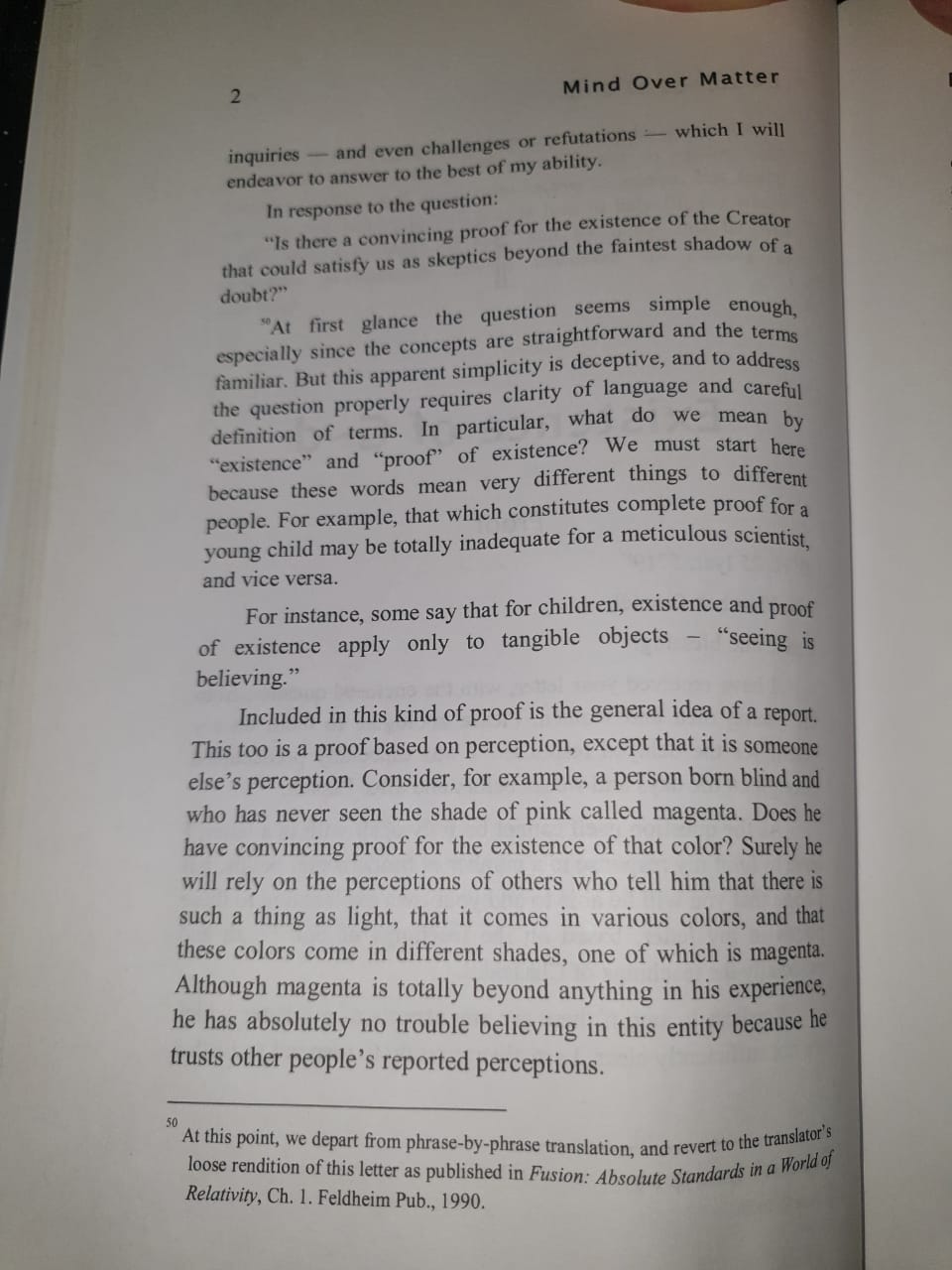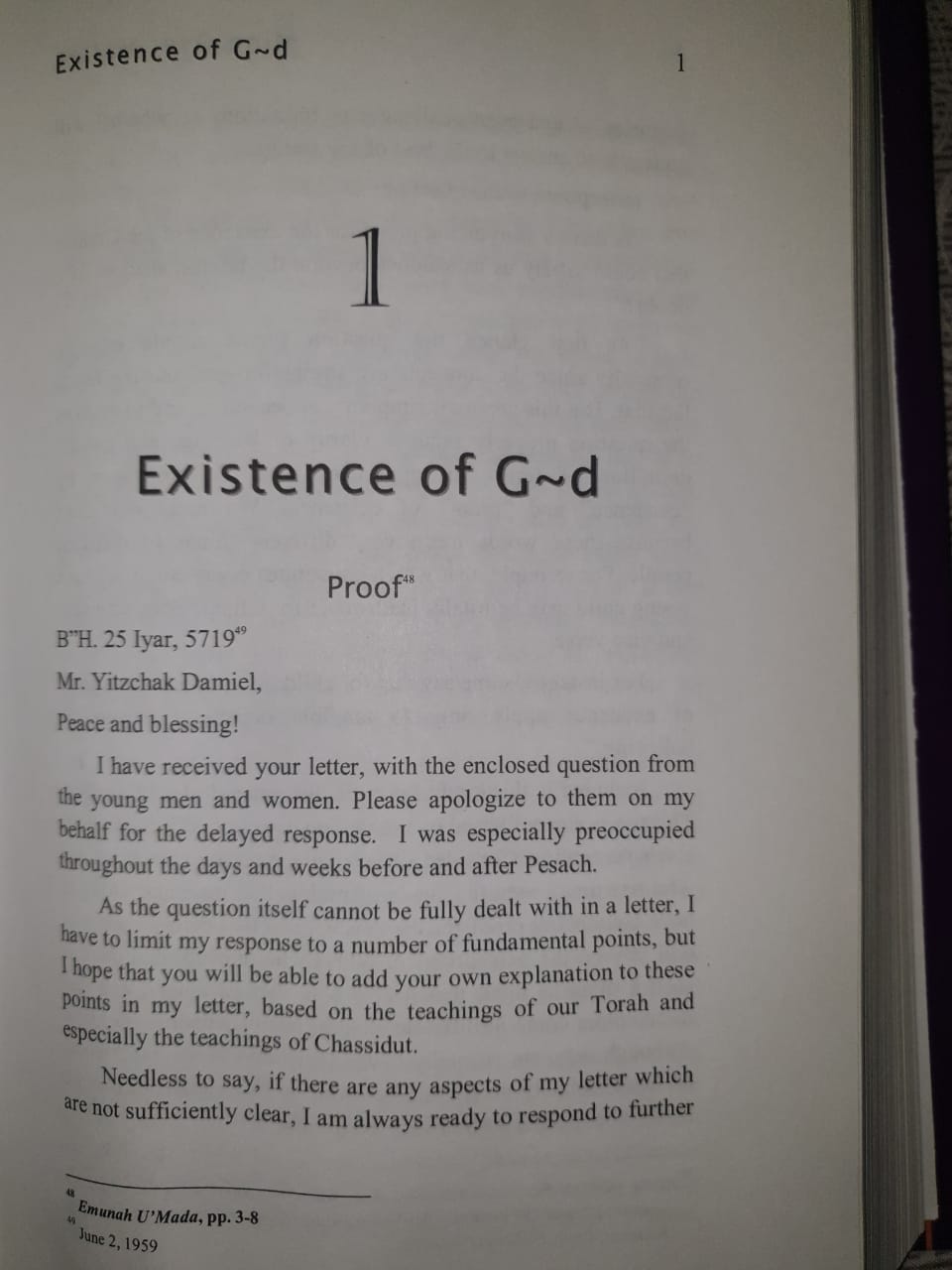I was recently told by a colleague from our COVID-19 combat task-force, an Israeli elite military unit soldier and paramedic, ICU Tel a Shomer Burn Center ex-staff: "Mankind thought it became almighty". It was said on the Eve of Passover, as a remark in the midst of a global pandemic.
After two weeks of non-stop preparations to face the imminent threat, I thought to myself: "Yes, we are looking for a physical solution, but all physical has a source in the spiritual realm. Where had we got wrong, what needs to fixed?
I found a fascinating letter of the Lubavitcher Rebbe, Menachem Mendel Schneerson, written 61 years ago, I would like to share with you. I think it is relevant to us all, especially at this time.
By before publishing it, let me share a quote from another letter of the Rebbe, now when we are about to launch crowdprotocol to pursue most effective coronavirus remedies: "Even many purely physical treatments have a far enhanced effect and success rate when the patient has a strong determination and spiritual fortitude".
I think now, like never before, the whole mankind became the patient.
“Is there a convincing proof for the existence of the Creator that could satisfy us as skeptics beyond the faintest shadow of a doubt?”
June, 2 1959
Mr. Yitzchak Damiel,
Peace and blessing!
I have received your letter, with the enclosed question from the young men and women. Please apologize to them on my behalf for the delayed response. I was especially preoccupied throughout the days and weeks before and after Pesach.
As the question itself cannot be fully dealt with in a letter, I have to limit my response to a number of fundamental points, but I hope that you will be able to add your own explanation to these points in my letter, based on the teachings of our Torah and especially the teachings of Chassidut.
Needless to say, if there are any aspects of my letter which are not sufficiently clear, I am always ready to respond to further inquiries — and even challenges or refutations — which I will endeavor to answer to the best of my ability.
In response to the question:
“Is there a convincing proof for the existence of the Creator that could satisfy us as skeptics beyond the faintest shadow of a doubt?”
At first glance the question seems simple enough, especially since the concepts are straightforward and the terms familiar. But this apparent simplicity is deceptive, and to address the question properly requires clarity of language and careful definition of terms. In particular, what do we mean by “existence” and “proof” of existence? We must start here because these words mean very different things to different people. For example, that which constitutes complete proof for a young child may be totally inadequate for a meticulous scientist, and vice versa.
For instance, some say that for children, existence and proof of existence apply only to tangible objects – “seeing is believing.”
Included in this kind of proof is the general idea of a report. This too is a proof based on perception, except that it is someone else’s perception. Consider, for example, a person born blind and who has never seen the shade of pink called magenta. Does he have convincing proof for the existence of that color? Surely he will rely on the perceptions of others who tell him that there is such a thing as light, that it comes in various colors, and that these colors come in different shades, one of which is magenta. Although magenta is totally beyond anything in his experience, he has absolutely no trouble believing in this entity because he trusts other people’s reported perceptions.
...it is assumed that anyone who is seeking a proof is not merely doing so for the sake of intellectual exercise, but would indeed live by his conclusions.
At a more abstract level, another perfectly acceptable kind of proof is reasoning from effect to cause. Everyone acknowledges with complete certainty that everything that happens has a reason and cause for happening. Thus when one sees actions, these themselves are proof of an activating force, even though this is not direct proof and superficially there appears to be room for doubt. A classic example is the existence of electric power. Man is a sentient being; his sense of sight verifies the existence of colors, his sense of hearing verifies the existence of sound, etc. These are considered complete, direct proofs; yet, while we can sense current, man has no faculty to perceive electric potential, or voltage. We only see its effects, such as a filament glowing or a voltmeter’s needle moving, etc. Still, we are certain of our conclusion that there exists some imperceptible force, which we term electricity, which is the reason behind what we do see. This is considered conclusive proof in the same way one proves the existence of magnetism and other forces. Electricity is a prime example because its existence is totally accepted beyond any shadow of a doubt.
The scientist’s faith in cause and effect is so intense that he will accept as undisputed fact the existence of an activating force, even if it plainly contradicts rationality. A case in point is the force of gravity. We are so familiar with the idea of gravity from every science book throughout our school years, that no one would dream of questioning it, even though rationally it is far more difficult to accept than electricity. Electricity is only imperceptible when it is still, but when it flows it can be felt and measured. Not so with gravity; no one has ever seen, felt or measured a wave or particle of gravity. Our only proof that the force of gravity exists is that physical bodies move. But how can a force act from afar with no intermediary whatsoever between the masses? With a remote controlled garage door or toy, there is a flow of measurable infrared or radio waves, but with gravity there is nothing but the simple faith that every action has a cause.
At first scientists tried to explain the force of gravity by assuming the existence of a fine mediating substance called ether. But the idea had to be abandoned because the proposed medium would have necessarily had so many contradictory properties that it became even more implausible than the alternative absurdity of remote action without any connection.

Anyone in the exact sciences who wonders whether the existence of the Creator can be reliably proven should consider another “standard” concept, derived from the realm of physics. This idea is so intellectually challenging that after many decades of study, even the experts admit it is beyond their comprehension. Nonetheless it is accepted by all exact scientists as a reality, and it is a proven fact in the eyes of the public. The idea referred to is that matter is nothing but a particular form of energy, and that it is possible to transform matter into energy and energy to matter. Superficially it may be hard to see what is so difficult about this notion of relativity. However if one takes a moment to consider the degree of similarity between the light now emanating from his bulb, and the shoe on his foot, and then tries to imagine converting one into the other and back again, the problem becomes crystal clear. Everything in our experience leads us to think that matter and energy are as fundamentally different as two things can be. Therefore, to say that they are equivalent does not even sound, say, reasonable-but-difficult; it simply sounds ridiculous.
As with gravity, the only compelling proof for relativity is that we see events that have no apparent explanation and if we accept the theory – they are explained. This is considered a scientific proof and, on this basis alone, relativity is accepted virtually everywhere as conclusively demonstrated beyond the faintest doubt, even though from a strictly rational standpoint, the equivalence of matter and energy is not at all compelling.
People act in accordance with their beliefs, and skeptics are no different. Hence it is reasonable to expect that a skeptic will feel free to use as a basis for action any ideas that are shown to meet his criteria of legitimacy. On this basis, there is not only one, but several proofs for the existence of G‑d and, as mentioned, there is no problem if one is forced to say that this existence is not grasped by the senses or the mind, or even if it contradicts rationality. As long as this existence accounts for observed reality and does so better than any other proposition, we have what is usually considered to be conclusive, scientific proof.
In this sense, proving the existence of the Creator is the same as proving anything else, whether in the realm of science or in the context of our daily lives.
But how can a force act from afar with no intermediary whatsoever between the masses? With a remote controlled garage door or toy, there is a flow of measurable infrared or radio waves, but with gravity there is nothing but the simple faith that every action has a cause.

Anyone who examines his daily conduct will admit that he doesn’t perform a penetrating, thorough analysis assessing the reliability of the information on which he bases his daily activities. If the weather forecast calls for rain, he wears his boots even though he has never met the weatherman or studied meteorology, and furthermore he knows that the weatherman is often wrong. For another example, if Vitamin E is reported to cure baldness, he will take it without knowing for sure how it works or if it works. He’ll take it without even knowing what it is. Rather he accepts the words of others who did look into the matter.
Only where there is some doubt that maybe the “information” was faked or that the observer was affected by internal or external factors, or that he wasn’t sure himself and took someone else’s view, etc…Then one would seek additional evidence. And with every increase in the number of observers, and with every type of variation in position, situation and context relative to the observers, the likelihood of deception becomes more remote and the evidence is strengthened in the form of a scientific and convincing proof. On this basis, the individual and society engage in all kinds of activities and projects, with complete trust that their conclusions are true and established.
So too in our case. The giving of the Torah on Mount Sinai was verified, generation after generation, as a fact proven by the presence of 600,000 adult males. If one includes women, children, Levites, men over sixty, etc., there were present millions of individuals, including Egyptian emigrants, who saw the events with their own eyes and experienced Divine communication personally and simultaneously.
This is not a testimony restricted to a single prophet, a dreamer or an elite group. This testimony was transmitted from parent to child, generation after generation, and everyone acknowledges that there was no interruption in the transmission from then until now. Moreover, there have never been less than 600,000 reporters in any generation, people whose characters were dissimilar and who were by no means afraid to disagree on basic issues, as is well documented from Sinai on. Yet, despite all their differences and arguments, and despite their being dispersed throughout the world for millennia, all the versions of the above historical event are similar in every detail. Is there more reliable and precise testimony than this?
Recent results of scientific research, regarding the existence of the universe and ways to “describe” it, contradict each other in numerous areas and indeed leave room for major doubts.
There is a second manner of proof which is also based on the premise above – that everything that happens has a cause that seeing any event or situation is proof positive that some guiding force exists, even if the event was apparently senseless or destructive. This proof is as follows:

Consider any object. Virtually anything that one can imagine is composed of various parts that are arranged and coordinated with remarkable precision. None of the parts has any inherent control over the others and yet we know that the harmonious and unified functioning of the entire system is itself a phenomenon and must be due to some cause. We conclude from this with complete confidence that there is an external power that binds and unifies all the parts. Moreover, the very fact that it binds and unifies the parts proves that it is stronger than they are since it controls them.
For example, if we were to enter a factory where everything was run automatically and we did not see anyone there, we would not doubt the existence and involvement of a great mechanic whose knowledge encompassed all the machinery and component parts and who controlled them – one who was in charge of their functioning among themselves and who maintained the connection between the parts and the control center. On the contrary – the more concealed the hand of man in such a factory, and the more the operations are automated, the more impressed and convinced we are of the mechanic’s remarkable skill.
And if this is the case with a factory, where we are speaking of hundreds, thousands, or even tens of thousands of parts, how much more true is this for natural objects, e.g., a piece of wood or stone, a plant or an animal, and – needless to say – the structure of the human body, as Job states, “From my flesh I will envision…”. This is especially so from the scientific perspective that every object is comprised of billions of atoms, with each atom containing even more minute parts. One would think, at first glance, that chaos would reign and yield incomparable disorder. But instead, we see an amazing orderliness and a marvellous fitting of the smaller parts to the larger, up to the very largest as well as the integration of microcosmic and macrocosmic patterns and processes, etc., etc. It is therefore clear beyond any shadow of a doubt that there exists a “Mechanic” responsible for all this.
One might say that all this is governed according to the “laws of nature” – but I think it is important to emphasize that such expressions have no explanatory content, but rather give a convenient summary or description of the existing situation. That is, it is true that natural phenomena are conducted according to definite patterns. But to say that a “Law of Nature” is a being in and of itself without dependence, and that this being rules throughout the cosmos, and that there are thousands of beings like it, according to the number of natural laws, is so absurd that there is not one scientist in the field who would say so. Rather it is the case that such laws are merely convenient, summary expressions for describing a situation, so that one should not be forced to duplicate at every turn a lengthy description of the “simple” facts. But however elegant and sophisticated a law of nature may be, it is clear and obvious that such an expression provides no explanation whatsoever.
Now to the heart of the matter. To put it plainly, everyone has criteria for what can be reliably considered true. If an idea meets those standards, it is fit to be believed and acted upon. If it does not, then it is not suitable for belief or as a basis for action. But one may not adopt certain truth criteria when it is convenient, and then drop them when it is not. Therefore, it is assumed that anyone who is seeking a proof is not merely doing so for the sake of intellectual exercise, but would indeed live by his conclusions.
Consider any object. Virtually anything that one can imagine is composed of various parts that are arranged and coordinated with remarkable precision. None of the parts has any inherent control over the others and yet we know that the harmonious and unified functioning of the entire system is itself a phenomenon and must be due to some cause.
In this regard it should be noted that the aforementioned proof is much stronger than all those proofs and evidence by which people conduct their daily lives. What simpler illustration is there than the fact that, when retiring at night, one arranges everything for the morning even though there is no logical proof that tomorrow morning the sun will rise yet again and that all natural systems will continue to function as they did yesterday and the day before. It is only that since the world has been working this way for so many days and years, one trusts that these “laws” will also rule tomorrow and the next day.
And on this basis alone, a person strives and troubles himself to prepare his affairs for the following morning, even though he has no logically compelling reason to do so. On the contrary, if chance or random probabilities were running the show, it would be more reasonable to assume that tomorrow will be utterly unpredictable. The conviction that nature will continue to function as it did today is only logically compelling when it is based on the knowledge that there really is a Master of the world.
Although more could be said on everything that was discussed above and certain points could be explained further, this should suffice and provide enough material for consideration and conclusion. For it is incorrect to maintain that the Creator’s existence requires proof, while His Creation itself exists beyond doubt, because in fact the opposite is true! Recent results of scientific research, regarding the existence of the universe and ways to “describe” it, contradict each other in numerous areas and indeed leave room for major doubts. But the most serious, significant and fundamental scientific doubt is as follows:
Who can establish whether the perceived impression of the eyes, of the ears, or of the brain generally, has any reality outside human sensation or thought? This argument poses an insurmountable challenge to the truth of the world’s existence but in no way applies to the Creator, nor to the functional reality of event causation and universal order. For this, practically speaking, it doesn’t matter whether there exists an independent reality or just the impression of such a reality. The primary consideration of the average person, and according to which he lives his whole life, is that for everything in his world there is a cause which acts, from within or without.
A further note of importance is that often human nature is such that when one is given a simple proof, it is difficult to accept because of its very simplicity. Such irrational rejection is unfortunate because it precludes any effect on personal behavior, while one of the foundations of our faith in the universe’s Creator and Director, as well as the stand at Sinai and the receiving of the Torah and its commandments, is that the quality of a person’s deeds is what matters most.
I will be pleased to hear responses to all the above, and as mentioned in the enclosed letter, I hope they will feel completely free to present their opinions, even if they disagree with what is written above.
With Blessing










